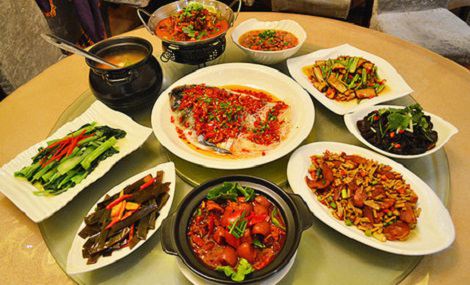Hunan cuisine, also known as Xiang cuisine, is celebrated as one of the Eight Great Culinary Traditions of Chinese Cooking. It consists of three distinct styles: the Xiang River style, which predominates in Changsha, Xiangtan, and Hengyang; the Dongting Lake style, which is characteristic of Yueyang, Yiyang, and Changde; and the Western Hunan style, which can mainly be found in Zhangjiajie, Jishou, and Huaihua. Evidence suggests that this style of cuisine had already reached a high standard during the Han Dynasty (206 BC–220 AD), over 2,100 years ago.
It is often compared to Sichuan-style cuisine thanks to its liberal use of chillies, but there’s much more to this complex cooking style than this simple comparison implies. Hunan cuisine is distinctly oilier than Sichuan cuisine, and uses a wider variety of fresh ingredients. While Sichuan-style cuisine is known to use Sichuan peppercorns that numb the mouth to spiciness, Hunan-style food utilises “chopped chillies” (剁辣椒) which have been pickled in vinegar and salt. These special chillies actually stimulate the taste-buds and make them more sensitive to spiciness, while also adding a sour tang to any dish. So, if you’re looking for a spicy kick, you might find Hunan food is actually hotter than Sichuan food!
Yet the spicy and sour flavours of Hunan cuisine aren’t simply there to delight the palate. Hunan province is known for its uncomfortably humid summers and chilly, wet winters. According to traditional Chinese medicine, both chillies and vinegar heat the body and are thus associated with “yang”, which means they will balance out an excess of “yin” caused by cold or dampness. Therefore many Hunan dishes are celebrated for their medicinal properties. When food tastes this good, you’ll be more than happy to take your medicine!
Dong’an Chicken (东安子鸡)
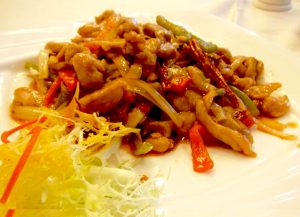 Dong’an Chicken is arguably Hunan province’s most famous poultry dish, and is known for its delicate mixture of subtle flavours. It is supposedly based on a dish known as “vinegar chicken”, which dates back to the Tang Dynasty (618-907). Although this may be true, a charming local legend recounts a very different origin story. Some say that it was invented by three old ladies who ran a modest, village restaurant. Late one evening, some merchants arrived at the restaurant and demanded to be served dinner. The women had used almost all of the ingredients in their pantry, so they were forced to improvise!
Dong’an Chicken is arguably Hunan province’s most famous poultry dish, and is known for its delicate mixture of subtle flavours. It is supposedly based on a dish known as “vinegar chicken”, which dates back to the Tang Dynasty (618-907). Although this may be true, a charming local legend recounts a very different origin story. Some say that it was invented by three old ladies who ran a modest, village restaurant. Late one evening, some merchants arrived at the restaurant and demanded to be served dinner. The women had used almost all of the ingredients in their pantry, so they were forced to improvise!
They quickly slaughtered a couple of chickens and rustled up a new dish using all of their leftover ingredients. The resulting dish was so delicious that the merchants spread word of it on their travels, and it eventually entered the canon as one of Hunan’s classic dishes. The dish is made by first parboiling a chicken with ginger and green onions, before allowing it to cool and cutting the carcass into bite-size pieces. Fresh chillies, dried chillies, ginger, and green onions are then sliced into slivers and fried in peanut oil until they start to smoke.
Finally, the chicken is added to the pan and is stir-fried along with a splash of Shaoxing rice wine, vinegar, and salt to taste. In some recipes, the chicken broth is also added to the mixture to keep the chicken tender and moist. Once the chicken is cooked through, it is left to simmer in the seasoned broth so that the flavours fully penetrate the meat. The result is a mildly spicy dish with a pleasant, sour tang that glances off the tongue.
Chairman Mao’s Red-Braised Pork (毛氏红烧肉)
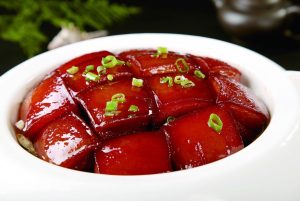 Mao Zedong, founding father of the People’s Republic of China, is a legendary figure in Chinese history. Since he was born and raised in Hunan, many of the province’s tourist attractions revolve around the Chairman. This dish was supposedly his favourite, so much so that it’s rumoured he ate it nearly every day! His nephew, Mao Anping, once extolled the dish by saying: “Men eat it to build their brains, and ladies to make themselves more beautiful”. Who knew that a simple pork dish could bestow such incredible gifts! In fact, this dish is so integral to the province’s history that the government actually issued official recipe guidelines to restaurants across the country. In order to be considered authentic, restaurants must use the meat of a rare breed of pig from Ningxiang County, which has been bred for over 1,000 years and is designated an “agricultural treasure”.
Mao Zedong, founding father of the People’s Republic of China, is a legendary figure in Chinese history. Since he was born and raised in Hunan, many of the province’s tourist attractions revolve around the Chairman. This dish was supposedly his favourite, so much so that it’s rumoured he ate it nearly every day! His nephew, Mao Anping, once extolled the dish by saying: “Men eat it to build their brains, and ladies to make themselves more beautiful”. Who knew that a simple pork dish could bestow such incredible gifts! In fact, this dish is so integral to the province’s history that the government actually issued official recipe guidelines to restaurants across the country. In order to be considered authentic, restaurants must use the meat of a rare breed of pig from Ningxiang County, which has been bred for over 1,000 years and is designated an “agricultural treasure”.
This is because the dish centres on sumptuous pork belly, which is flavoured with fragrant star anise, ginger, cinnamon, and chillies. The pork belly is quickly boiled before being left to cool and then cut into bite-size pieces. Meanwhile, oil and sugar are combined in a wok over a low heat until the sugar has turned a rich, caramel brown. The pork is then added to the caramelized sugar, along with a splash of Shaoxing rice wine. Finally, the ginger, star anise, chillies, and cinnamon are added to the pork, along with just enough water to barely cover the ingredients. This flavourful mixture is left to simmer for between 40 minutes to an hour. It is considered one of the mildest dishes in the Hunan canon, and the pork belly is said to literally melt in the mouth.
Steamed Fish with Chopped Chillies (剁椒鱼头)
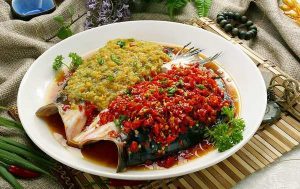 This dish was recently catapulted into the international spotlight thanks to an unusual new trend in Hunan where, instead of serving a whole fish, the dish is made using only the head of a bighead carp. So, if you think something might be a little fishy, be sure to ask the waiter exactly what you’re getting before you order! It’s said to date back to the Qing Dynasty (1644-1912), when a famous mathematician named Huang Zongxian was travelling through Hunan. One night, he was staying with a local family and their son happened to catch a fish from a nearby pool.
This dish was recently catapulted into the international spotlight thanks to an unusual new trend in Hunan where, instead of serving a whole fish, the dish is made using only the head of a bighead carp. So, if you think something might be a little fishy, be sure to ask the waiter exactly what you’re getting before you order! It’s said to date back to the Qing Dynasty (1644-1912), when a famous mathematician named Huang Zongxian was travelling through Hunan. One night, he was staying with a local family and their son happened to catch a fish from a nearby pool.
The hostess steamed the fish with a mixture of chopped chillies before serving it to the guests. Huang found the dish so delicious that he immediately asked for the recipe, and brought it back home with him. The recipe spread far and wide, gaining favour across the country. It is one of the simplest Hunan dishes to prepare, but certainly no less flavourful! Green onions, ginger, Shaoxing rice wine, salt, chopped garlic, and chopped red chillies are stir-fried in a wok until they give off a rich, pleasant aroma. This mixture is then ladled on top of the fresh fish, which in turn is placed in a steamer and steamed for approximately 20 minutes. The tender flesh simply flakes off the bone, and is laden with just enough chillies to provide a kick without overwhelming the natural flavour of the fish.
Lovers’ Hot Pot (鸳鸯火锅)
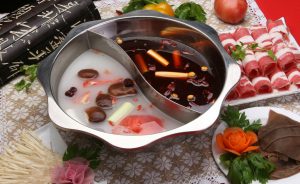 Hot pot is an exceedingly popular dish throughout China, particularly during the cold winter months, as it is believed to warm the blood. The basic dish consists of a seasoned broth, which is placed at the centre of the table and heated over a hot plate. Diners order a selection of raw ingredients and then add them to the bubbling broth as they please, picking them out and eating them once they are thoroughly cooked.
Hot pot is an exceedingly popular dish throughout China, particularly during the cold winter months, as it is believed to warm the blood. The basic dish consists of a seasoned broth, which is placed at the centre of the table and heated over a hot plate. Diners order a selection of raw ingredients and then add them to the bubbling broth as they please, picking them out and eating them once they are thoroughly cooked.
In Hunan, the locals have a marked preference for a style known as “yuanyang” or “lovers” hot pot. It is so-called because the pot is split into two sides, one with a spicy broth and one with a mild broth. In short, it is the veritable yin-yang of the hot pot world! The spicy broth is typically thick with chillies as red as rubies, while the mild broth uses ingredients like goji berries and star anise to soothe the taste-buds and prepare them for the next assault of spiciness. Most hot pot vendors keep their broth recipes a well-guarded secret, so you’ll find that each restaurant brings its own unique twist to this time-honoured dish!
